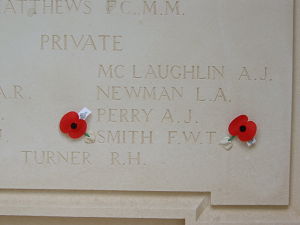WW1 Private Frederick William Thomas (Tom) Smith 46397
Tom was born on 22 September 1894 to Frederick and Elizabeth Smith, of 4, Walton St., Remuera, which was off Victoria Avenue and up to 1917, was called Hobson Place.
He was educated at Remuera Primary School and on enlistment on 13th November 1916 was a self-employed builder. He embarked on 26 Apr 1917 on the Tofua to Plymouth, Devon, England as part of the 25th Reinforcements, Auckland Infantry Regiment, A Company, arriving on 19 July 1917. On 5 September 1917 Tom proceeded overseas from Sling camp to the Base Depot at Etaples France and joined the 1st Battalion Auckland Regiment. On 19.12.1917 he was detached to the Australian Tunnellers for one month. On 28 January 1918 he was evacuated sick to hospital for 2 days and again on 24 March for 4 days after injuring his leg playing football in a divisional game. On 11.4.18 he was admitted No.20 General Hospital at Camiers and then to the convalescent depot at Etaples Camp with a contused (bruised) right leg. After discharge on 5th May 1918, Tom was transferred to the 22 Corps Cyclist Battalion. [1]
The New Zealand Cyclist Corps was added to the New Zealand Division in April 1916. Starting as a single company, it was formed in New Zealand from men training to be mounted riflemen. The unit arrived on the Western Front in July 1916, when it was split into two companies and was attached to II Anzac Corps. For most of the war it did not fight with the rest of the New Zealand Division but as a separate unit attached to other corps within the British Army. Cyclist battalions performed a similar function to mounted riflemen, conducting scouting and reconnaissance work. Like mounted riflemen they were of little value in trench warfare conditions, so spent much of the war on navvying work. They were particularly involved with burying telegraph cables, and at times served in the trenches as infantrymen. The New Zealand cyclist companies served exclusively on the Western Front, participating in the Messines and Passchendaele offensives in 1917 and the Spring Offensive and Advance to Victory in 1918. In January 1918 a third New Zealand company was created to replace an Australian one that had been transferred. The three New Zealand companies were then designated XXII Corps Cyclist Battalion. In September 1918 the unit was renamed the New Zealand Cyclist Battalion. [2]
On 23 July 1918 Tom was killed in action in the field in France, aged 23 years. He is remembered at the Marfaux (New Zealand) Memorial which takes the form of a panel stone erected in the shelter in Marfaux British Cemetery. It commemorates, by name, 10 casualties of the New Zealand Cyclist Battalion who fell in July 1918 and who have no known grave. [3]
Tom Smith is also commemorated on the Remuera Primary School gates and the memorial cross at St Aidan’s Church.

